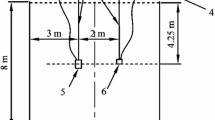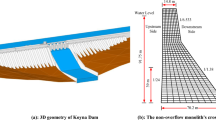Abstract
On March 26, 2010 an underwater explosion (UWE) led to the sinking of the ROKS Cheonan. The official Multinational Civilian-Military Joint Investigation Group (MCMJIG) report concluded that the cause of the underwater explosion was a 250 kg net explosive weight (NEW) detonation at a depth of 6–9 m from a DPRK “CHT-02D” torpedo. Kim and Gitterman (2012a) determined the NEW and seismic magnitude as 136 kg at a depth of approximately 8m and 2.04, respectively using basic hydrodynamics based on theoretical and experimental methods as well as spectral analysis and seismic methods. The purpose of this study was to clarify the cause of the UWE via more detailed methods using bubble dynamics and simulation of propellers as well as forensic seismology. Regarding the observed bubble pulse period of 0.990 s, 0.976 s and 1.030 s were found in case of a 136 NEW at a detonation depth of 8 m using the boundary element method (BEM) and 3D bubble shape simulations derived for a 136 kg NEW detonation at a depth of 8 m approximately 5 m portside from the hull centerline. Here we show through analytical equations, models and 3D bubble shape simulations that the most probable cause of this underwater explosion was a 136 kg NEW detonation at a depth of 8m attributable to a ROK littoral “land control” mine (LCM).
Similar content being viewed by others
References
Barger JE, Hamblen WR (1980). The air gun impulsive underwater transducer. J. Acoustic. Soc. Am., 68(4), 1038–1046.
Baumgardt DR, Der Z (1988). Identification of presumed shallow chemical explosions using land-based regional arrays. Bull. Seism. Soc. Am., 88(2), 581–595.
Booth DC (2009). The relation between seismic local magnitude ML and charge weight for UK Explosions, Keyworth, Nottingham, BGS, UK, British Geological Survey, Earth Hazards Programme, OR/09/062, Open Report pp. 25.
Brocher TM (2003). Detonation charge size versus coda magnitude relations in California and Nevada. Bull. Seism. Soc. Am., 93 (5), 2089–2105.
Cohen TJ (1970). Source-depth determination using spectral, pseudo-autocorrelation and cepstralanalysis. Geophys. J. R. astr. Soc., 20, 223–231.
Cole RH (1948). Underwater Explosions. Princeton Univ. Press, Princeton, NJ, USA, 437.
De Giorgi VG, Thomas ED, Lucas KE (1998). Scale effects and verification of modeling of ship cathodic protection systems. Eng. Anal. Bound.Elements., 22, 41–49.
Ditchfield RW, McGrath JN, Tighe-Ford DJ (1995). Theoretical validation of the physical scale modeling of the electrical potential characteristics of marine impressed current cathodic protection. J. Applied Electrochemistry, 25, 54–64.
Gong SW, Ohl SW, Klaseboer E (2010). Scaling law for bubbles induced by different external sources: theoretical and experimental study. Physical Review, E 81 056317, 1–11.
Gonzalez-Avila SR, Klaseboer E, Khoo BC, Ohl C (2011). Cavitation bubble dynamics in a liquid gap of Variable height. Journal of Fluid Mechanics, 682, 241–260.
Huber T, Wang Y (2012). Effect of propeller coating on cathodic protection current demand: sea trial and modeling studies. Corrosion, 68, 441–448.
Jacob AWB, Neilson G (1977). Magnitude determination on LOWNET. Edinburgh, UK, Institute of Geological Sciences, GSU, Report, 86.
Jacob AWB (1975). Dispersed shots at optimum depth-an efficient seismic source for lithospheric studies. J. Geophysics, 41, 63–71.
Khalturin VI, Rautian TG, Richards PG (199). The seismic signal strength of chemical Explosions. Bull. Seism. Soc. Am. 88(6), 1511–1524.
Kim SG, Gitterman Y (2012a). Underwater explosion (UWE) analysis of the ROKS Cheonan Incident. Pure and Appl. Geophys, 169, doi:10.1007/s00024-012-0554-9.
Kim SG, Gitterman Y (2012b). A source verification of the underwater explosion (UWE) for the ROKS Cheonan accident. The 9th General Assembly of the ASC, Ulaanbaatar, Mongolia, 296.
Klaseboer E, Khoo BC, Hung KC (2005). Dynamics of an oscillating bubble near a floating structure. J. of Fluids and Structure, 21, 395–412.
Klaseboer E, Hung KC, Wang C, Wang, CW, Khoo BC, Boyce P, Debono S, Charlier H (2005). Experimental and numerical investigation of the dynamics of an underwater explosion bubble near a resilient/rigid structure. Journal of Fluid Mechanics, 537, 387–413.
Krieger JR, Chahine GL (2005). Acoustic signals of underwater explosion near surfaces. J. Acoustic. Soc. Am., 118(5), 2961–2974.
Lake JR, Gibson DC (1987). Cavitation bubbles near boundaries. Annual Review of Fluid Mechanics, 19, 99–123.
Lee M, Klaseboer E, Khoo, BC (2007). On the boundary integral method for the rebounding bubble. J. Fluid Mechanics, 570, 407–429.
Magnaudet J, Eames I (2000). The motion of high-Reynolds-number bubbles in homogeneous flows. Annual Review of Fluid Mechanics, 32, 659–708.
MCMJIG (Multinational Civilian-Military Joint Investigation Group) (2010). On the attack against ROK ship Cheonan. Seoul, ROK, Joint Investigation Report, Ministry of National Defense, 313.
Plesset MS, Chapman RB (1971). Collapse of an initially spherical cavity in the neighbourhood of solid boundary. J. of Fluid Mechanics, 47, 283–290.
Plesset MS, Prosperetti A (2000). Bubble dynamics and cavitation. Annual Review of Fluid Mechanics, 19, 145–185.
Rayleigh L (1917). On the pressure developed in a liquid during the collapse of a spherical cavity. Philosophical Magazine Series 6, 34, 94–98.
Swisdak MM (1978). Explosion effects and properties: part III-explosion effects in water. Dahlgren, VA, USA, NSWC/WOL, TR 76-116, 109.
Wang QX, Yeo KS, Khoo BC, Lam KY (1996). Nonlinear interaction between gas bubble and free surface. Computer & Fluids, 25(7), 607–628.
Wang QX, Blake JR (2011). Non-spherical bubble dynamics in a compressible liquid. Part 2. Acoustic standing wave. J. of Fluid Mechanics, 679, 559–3581.
Weinstein MS (1968). Spectra of acoustic and seismic signals generated by underwater explosions during chase experiment. J. of Geophysical Research, 73(16), 5473–5476.
Willis DE (1963). Seismic measurements of large underwater shots. Bull. Seism. Soc. Am., 53(4), 789–809.
Wu J, Xing S, Yun F (2009). The influence of coating damage on ICCP cathodic protection effect. Simulation of Electrochemical Processes III, WIT Trans. on Eng. Sc., 65, 89–96.
Zhang YL, Yeo KS, Khoo BC, Wang C (2001). 3D jet impact and toroidal bubbles. J. Comput. Phys., 16(6), 336–360.
Zhang AM, Yao XI, Li J (2008). The interaction of an underwater explosion bubble and an elastic-plastic structure. Applied Ocean Research, 30, 159–171.
Author information
Authors and Affiliations
Corresponding author
Additional information
So Gu Kim is currently director of the Korea Seismological Institute and his research has covered a very wide range of topics in seismology, marine geophysics and oceanography (underwater acoustics and signal processing). He has about 100 publications in the international journals as well as more publications in the national journals including authoring four professional books. He was an invited professor at Hamburg University (Germany), New England University (Australia), GFZ Potsdam (Germany), Hokkaido University (Japan) and Peking University (China) as well as being a professor of physics and geophysics at Hanyang University, Korea for 30 years. His research highlights are in using his expertise to analyze the complicated problems which are involved in geophysics and ocean engineering (e.g. underwater explosion).
Rights and permissions
About this article
Cite this article
Kim, S.G. Forensic seismology and boundary element method application vis-à-vis ROKS Cheonan underwater explosion. J. Marine. Sci. Appl. 12, 422–433 (2013). https://doi.org/10.1007/s11804-013-1213-y
Received:
Accepted:
Published:
Issue Date:
DOI: https://doi.org/10.1007/s11804-013-1213-y




